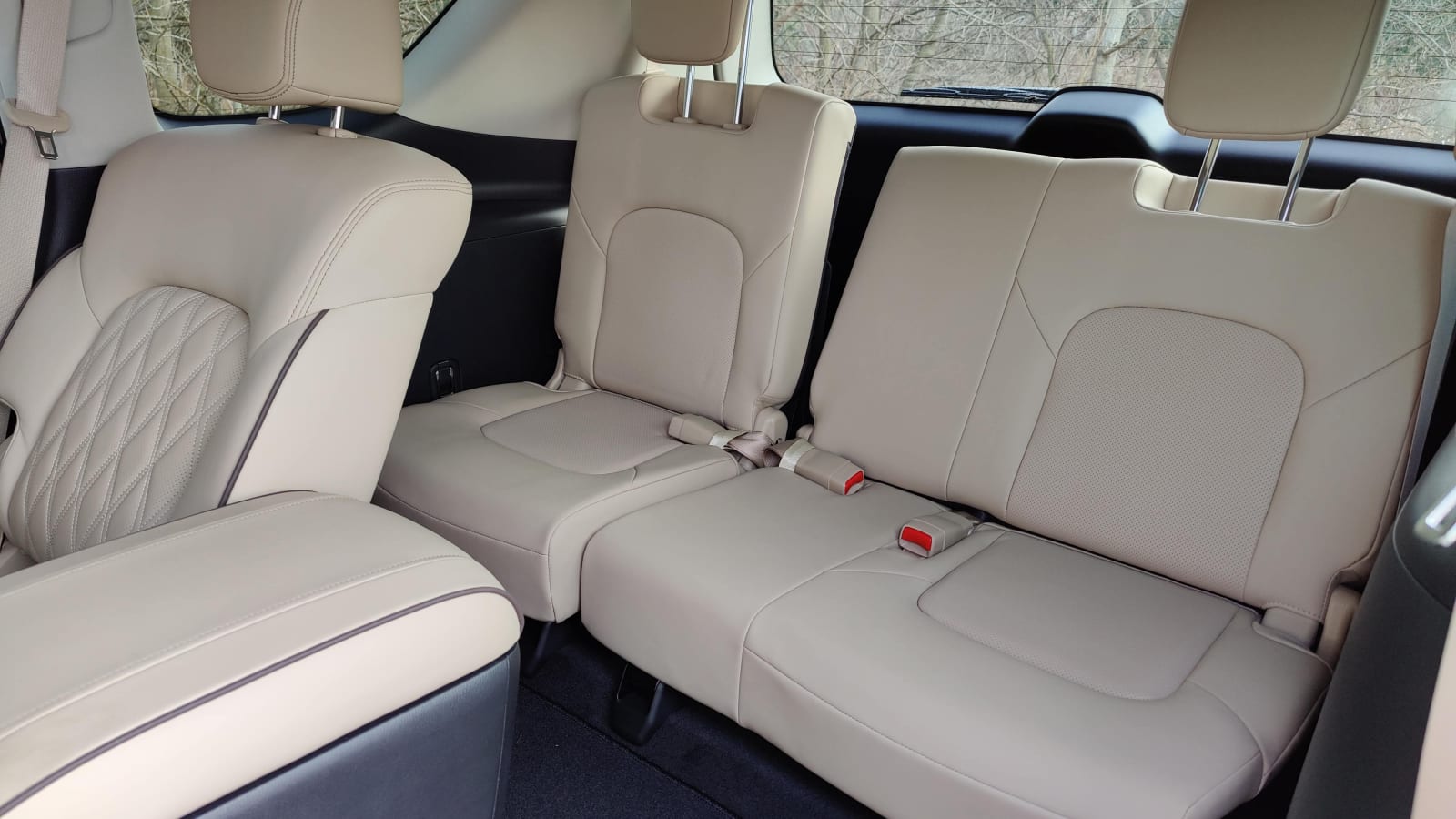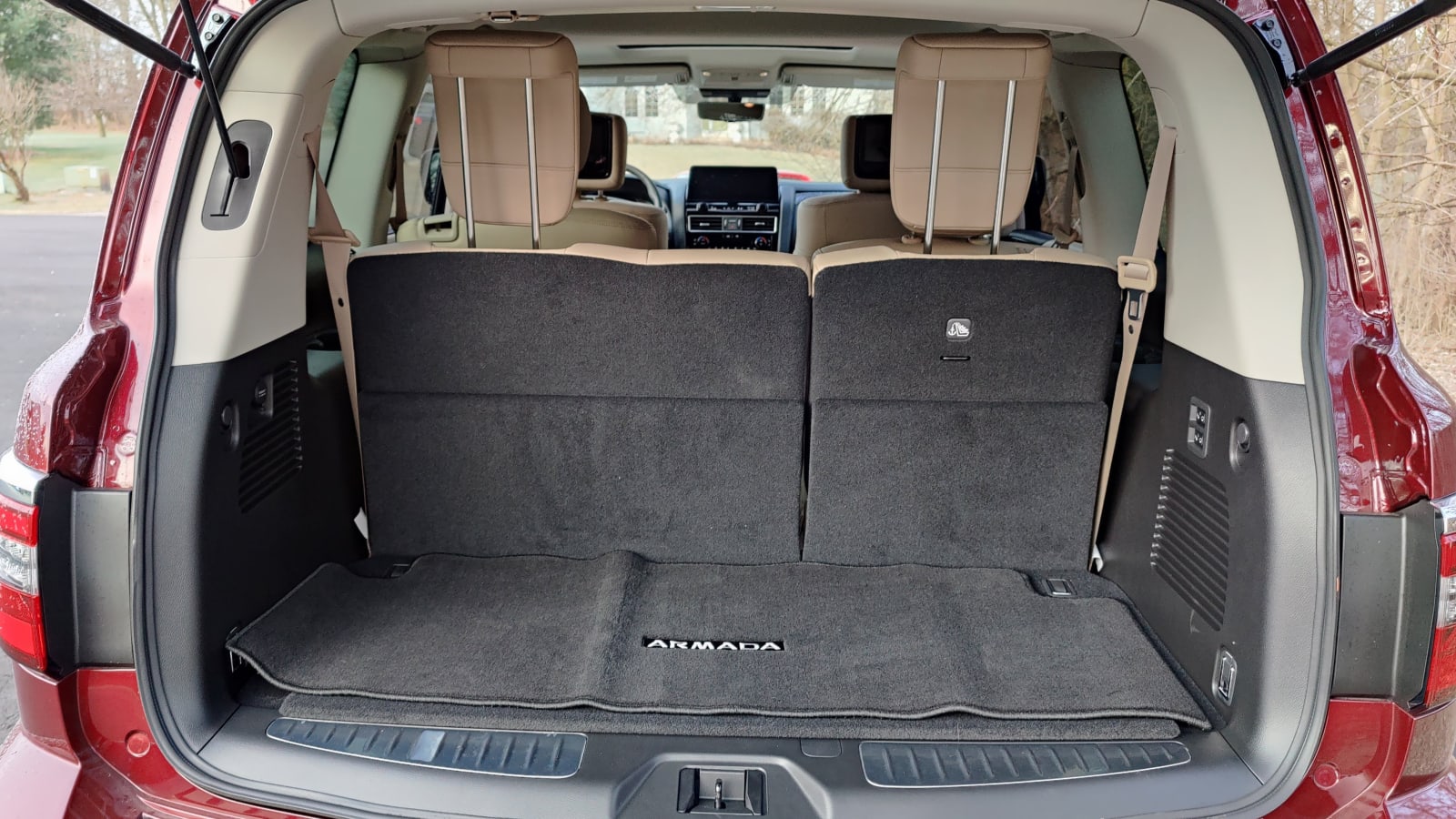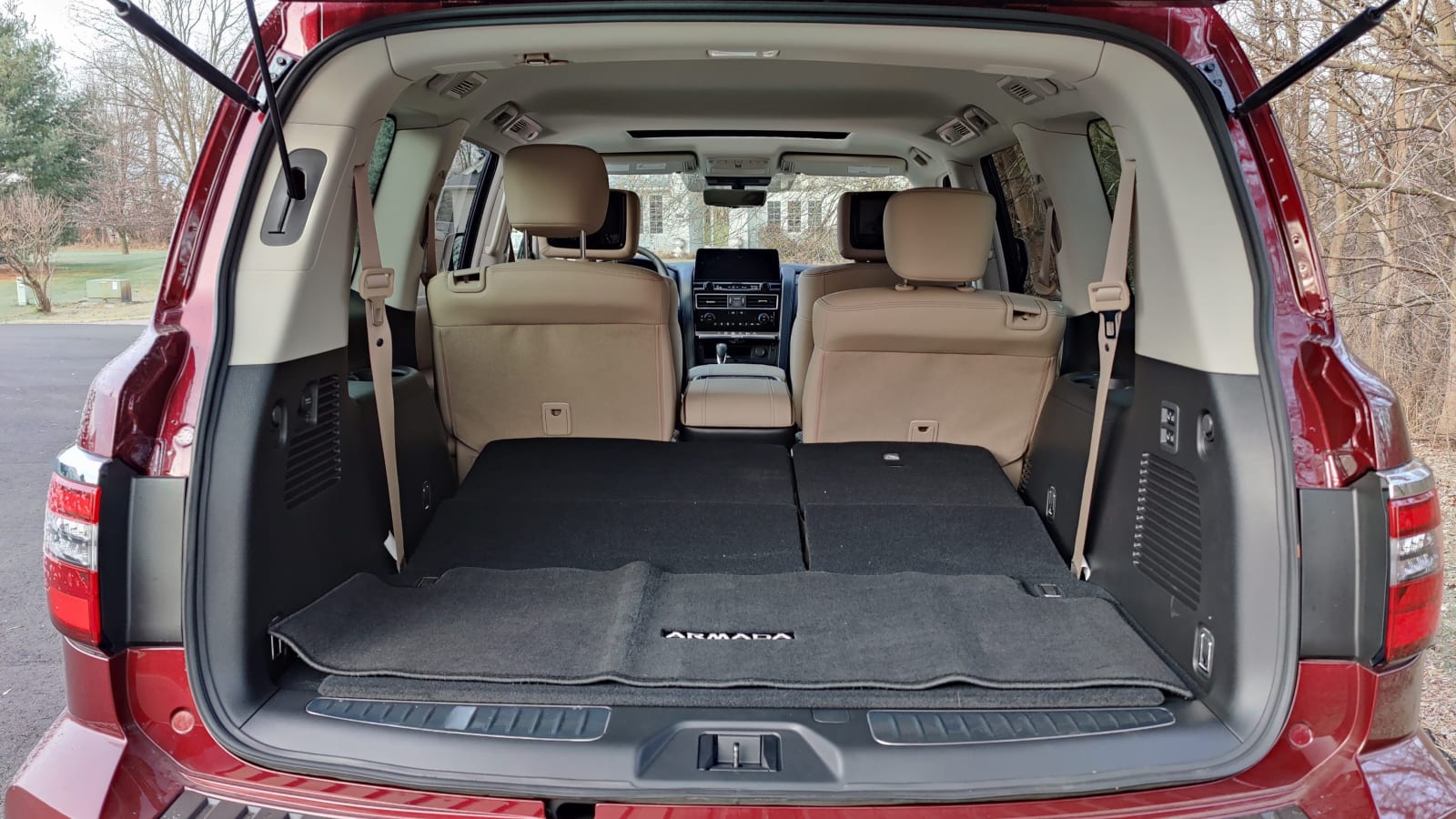The 2021 Nissan Armada is the first product in the United States to wear the Nissan brand’s new badge. It’s a modern and sleek-looking logo, and it’s well-suited to the properly sorted and genuinely impressive new vehicles Nissan recently launched. The new Altima surprised us in a good way; the redesigned Rogue and Sentra took huge leaps forward, and even the Versa is an impressive little sedan now.
However, the refreshed Armada is only that: a mildly updated version of the same Armada. Since it’s the company’s flagship SUV, it gets the honor of wearing the new logo first, even if it doesn’t best exemplify the sea change happening at Nissan. Although the second-generation Armada debuted four years ago, its bones date back to 2011 when the internationally sold Nissan Patrol and its Infiniti QX56 (later QX80) offshoot debuted. The Patrol would be the basis for this Armada generation, but unfortunately, the updates for 2021 don’t add any of the Patrol’s extra off-roading equipment that have been missing since the beginning. That includes the locking front and rear differentials, disconnecting sway bar and Hydraulic Body Motion Control suspension that links all four corners of the car hydraulically for better on-road control and less harshness off-road. The only off-road upgrade to speak of for 2021 is a two-degree better approach angle thanks to a reshaped front bumper.
In fact, the mechanicals are largely carryover. Every Armada is powered by a 5.6-liter V8 paired with a seven-speed automatic transmission. Output increases to 400 ponies and 413 pound-feet of torque this year. The 10-horsepower increase is only experienced when running on premium fuel (as in the QX80) — if you drop down to regular grade, you’ll be making the same 390 horsepower as before. Poor fuel economy comes regardless, as the rear-wheel-drive version gets 16 mpg combined, and the four-wheel-drive model achieves 15 mpg combined. We saw 17 mpg in the trip computer on a highway-heavy trip of approximately 100 miles in a four-wheel-drive Platinum model.
Nissan redesigned the grille, headlights, hood, front fenders, rear bumper and taillights. The big SUV looks new from the front and the back, but the side profile is hardly distinguishable from the 2020 Armada. Of all the exterior changes, Nissan’s new LED lighting does the most to bring the Armada into this decade. There’s still too much chrome mussing up some of the finer styling points, but the Armada is definitely better looking than before. And if you really hate the chrome, there’s a Midnight Edition that’ll black everything out.
All interior attention has gone toward completely redesigning the center stack and gear lever surround. The infotainment system and its mess of buttons from forever ago are all gone. A huge number of superfluous buttons were trashed and those that remain have been replaced by Nissan’s current switchgear. Topping the new slab of controls is a massive 12.3-inch widescreen touch display with crisp graphics and vibrant colors. It runs wireless Apple CarPlay and wired Android Auto (both standard), but it does chop off part of the screen when you’re running those smartphone apps. Neither app stretches across the full width of the screen, but thankfully, Nissan makes good use of the extra space with a customizable display box that’ll fill up the emptiness with info like the current media playing or a fancy clock. The occasional touch from our fingers was not recognized by the display, but that could be a pre-production issue Nissan will iron out by the time the Armada goes on sale next year. You’ll want to navigate the screen via touch, too, because the rotary dial controller and UX don’t mesh well together the way they do with BMW’s iDrive.
Other interior upgrades like the new 7-inch instrument panel screen, additional USB outlets (now with USB A and C) and a wireless phone charger do well to modernize the cabin. Everything outside of these specific areas is carryover, unfortunately. The dash design is compromised by its blend of eras: the jumbo touchscreen and angular center stack controls below clashing with the more organic, rounded shapes on either side. The curvy vent openings look especially out of place. It’s also worth noting that the “new” Armada interior looks nothing like those found in actual-new Nissans like the Altima, Sentra and Rogue.
Since Nissan hasn’t done so much as tweak the suspension for 2021, there’s not much to report from behind the wheel. You sit way up high from a flat throne of either leather or cloth depending on trim. Visibility is superb with big windows and a large windshield. The optional rear camera mirror is improved with a higher resolution display this year, and the addition of a 360-degree bird’s eye view camera makes navigating in tight spaces even easier.
Straight-line acceleration is solid once you get the revs up, but it’s a slow and lazy-revving engine. Transmission response is decent for a big bruiser like this one, as it pops right down into low gear when you mash the throttle for highway on-ramps or passing maneuvers. There’s a bit of V8 growl that gets through into the cabin, and the new acoustic windshield does a good job of keeping unpleasant sounds out.
The Armada rides well given its off-road capabilities, but the body-on-frame construction makes itself known over potholes, frost heaves and dirt roads with some harshness and bounciness. It rides a bit like a buttoned-down pickup, but a comfortable one, like the Ram 1500. You can soak up highway miles in relative comfort assuming the road is in decent condition. However, the vague steering and lack of any lane-centering technology means the steering wheel requires more attention than we’d prefer. The best lane-keeping driver assistance tech Nissan offers here is a horrible and incessant steering wheel buzzing should you veer close to a lane marker. The vibration is so loud and annoying that everybody in the car can hear it. Adaptive cruise control can be had, but it’s not particularly smooth or quick to react.
The inherent top-heavy feeling and off-road truck-like steering instantly discourages any handling explorations. It’ll hold a line in a corner with some confidence, but any amount of fun you have driving the Armada will be had off-road. We didn’t send it through any off-road trails this time around, but our 2017 first drive saw us through an off-road park where the Armada proved its truck credentials. It trundled up and over steep mounds and can even keep it together in sections that require some articulation — the Armada features a rugged, independent double wishbone suspension at all four corners.
For those who are planning on towing with their Armada, you’ll be happy to know that Nissan added a trailer brake controller that will be standard on every trim level. It’s still a very capable tow vehicle, maxing out at 8,500 pounds. Those roof rails can handle up to 220 pounds. The second row is super-spacious with tons of legroom and a large center console when equipped with captain’s chairs. Maximum seating capacity is eight, and while the third row is much smaller than what you’ll find in the Ford Expedition and new Chevy Tahoe, the chairs can be reclined backwards to a position comfortable for adults — keep in mind, this trick does intrude on cargo capacity. Indeed, if passenger and cargo space is of paramount importance, either of those American rigs would be a better choice.
![]()
![]()
![]()
![]()
There’s still no pricing information available for the updated Armada, but the 2020 model started at $48,895 for the SV trim. Nissan says the 2021 will introduce a base S model, but we’re left in the dark for where that one will start. The new Tahoe starts at $50,295, and the Expedition at an even pricier $54,505. That means the Nissan will likely come in cheaper than the two biggest sellers in the segment. Good if you want maximum space for minimum dollar, but these updates still don’t sway us enough to recommend Nissan over the much more modern and efficient American stalwarts. Some of the money you initially save over those two will be paid back in fuel costs later, as the EPA estimates the four-wheel-drive Armada will cost $450 more per year in fuel than a similarly equipped Expedition and $350 more than a Tahoe.
Both the Toyota Sequoia and Land Cruiser deserve mention in this category of vehicles, but their bones are even older than the Armada’s at this point. The Nissan’s interior is far superior with this update, but if you’re planning on sticking with your purchase for a long time (or venturing off-road in the case of the Land Cruiser), the Toyotas deserve credit for their longevity and lack of depreciation through the years. Of course both Toyotas suffer from 14 mpg combined ratings themselves, making them even more expensive ($150 per year) to drive than the Armada.
In total, the changes are not revolutionary enough to even approach the Expedition and new Tahoe or to catapult the Armada to the top of this class. If we were able to spec the off-road goodies available on the Patrol in the U.S., a case could be made for the Armada as a budget Land Cruiser. Until Nissan takes a more comprehensive approach at a redesign, though, the Armada makes its best case as a value play with above-average off-road chops.
Related video:
Source link





